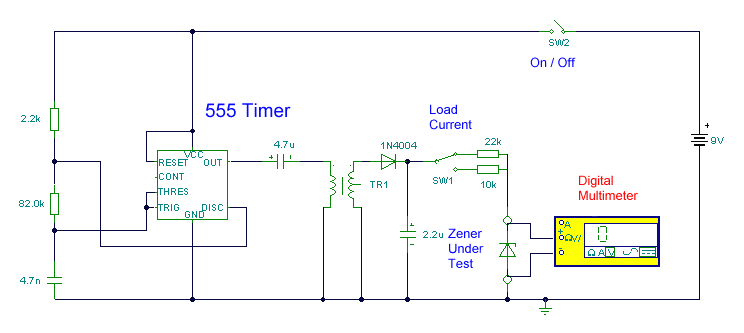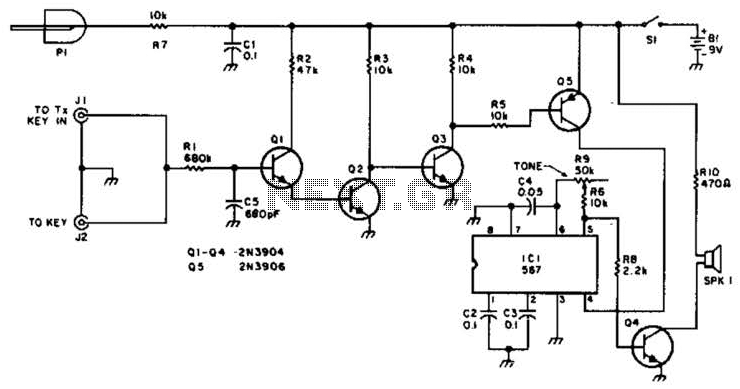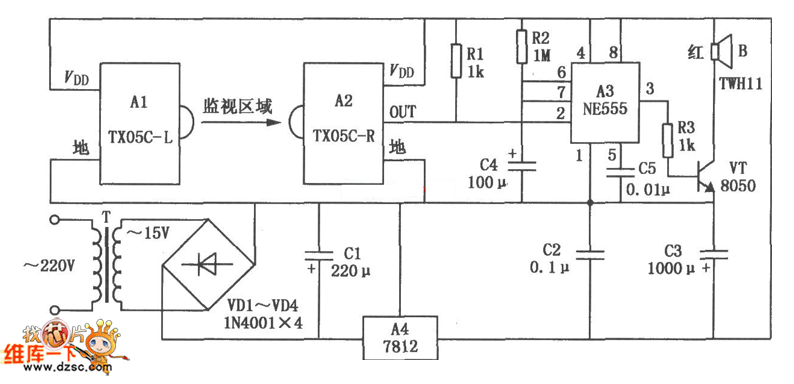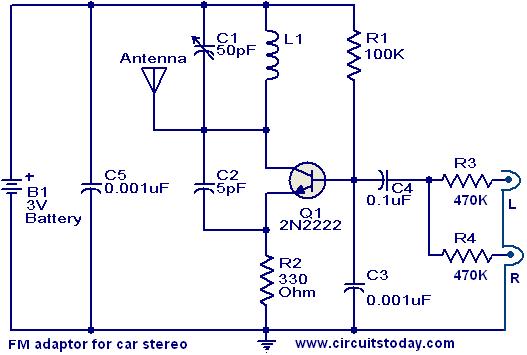
Two star flasher circuit
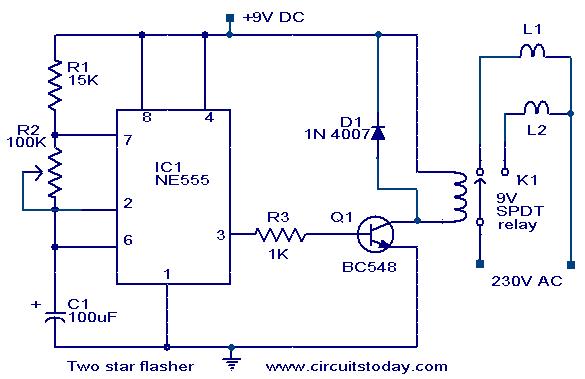
A circuit designed to alternately flash two Christmas stars is presented. The NE555 integrated circuit (IC1) is configured as an astable multivibrator. When IC1 outputs a positive pulse, transistor Q1 becomes conductive, activating relay K1. Consequently, lamp L2, connected through the normally open (N/O) contact of the relay, illuminates. Once the output pulse from the IC drops low, Q1 turns off, deactivating the relay. This results in lamp L2 extinguishing and lamp L1, connected via the normally closed (N/C) contact of the relay, lighting up. This alternating cycle persists as long as the circuit is powered. The timing for the lamps can be modified by adjusting the preset resistor R2.
The circuit operates using the NE555 timer in astable mode, generating a continuous square wave output. The frequency of this output is determined by the resistors R1 and R2, as well as the capacitor C1, which together set the timing intervals for the flashing sequence. The output pulse from the NE555 triggers Q1, which is typically a bipolar junction transistor (BJT) or a MOSFET, allowing current to flow to the relay coil.
Relay K1 serves as a switch to control the lamps L1 and L2. When activated, it connects the power supply to lamp L2 through its N/O contact. As the NE555 output transitions low, Q1 turns off, the relay coil is de-energized, and the connection to lamp L2 is interrupted. The relay's N/C contact then completes the circuit for lamp L1, causing it to illuminate.
The overall design allows for a visually appealing effect suitable for decorative lighting during festive occasions. The adjustable timing through R2 provides flexibility in the flashing speed, enabling customization according to user preference. Proper selection of components, including the relay's current rating and the lamps' voltage and power specifications, is crucial to ensure reliable operation and safety. Additionally, consideration should be given to the power supply voltage to match the requirements of the NE555 and the relay.A circuit that can be used to flash two Christmas stars alternatively is given here. The IC1 NE 555 is wired as an astable multivibrator here. When there is a positive pulse from the output of IC1, the transistor Q1 conducts and the relay K1 gets activated. The lamp L2 connected via the N/O contact of the relay glows. When the output pulse of the IC goes low, the Q1 goes OFF and the relay gets deactivated. Now the lamp L2 extinguishes and the lamp L1 connected via the N/C contact of the relay glows. This cycle continues as long as there is power supply for the circuit. The timing of the lamps can be adjusted by varying the preset R2. 🔗 External reference
The circuit operates using the NE555 timer in astable mode, generating a continuous square wave output. The frequency of this output is determined by the resistors R1 and R2, as well as the capacitor C1, which together set the timing intervals for the flashing sequence. The output pulse from the NE555 triggers Q1, which is typically a bipolar junction transistor (BJT) or a MOSFET, allowing current to flow to the relay coil.
Relay K1 serves as a switch to control the lamps L1 and L2. When activated, it connects the power supply to lamp L2 through its N/O contact. As the NE555 output transitions low, Q1 turns off, the relay coil is de-energized, and the connection to lamp L2 is interrupted. The relay's N/C contact then completes the circuit for lamp L1, causing it to illuminate.
The overall design allows for a visually appealing effect suitable for decorative lighting during festive occasions. The adjustable timing through R2 provides flexibility in the flashing speed, enabling customization according to user preference. Proper selection of components, including the relay's current rating and the lamps' voltage and power specifications, is crucial to ensure reliable operation and safety. Additionally, consideration should be given to the power supply voltage to match the requirements of the NE555 and the relay.A circuit that can be used to flash two Christmas stars alternatively is given here. The IC1 NE 555 is wired as an astable multivibrator here. When there is a positive pulse from the output of IC1, the transistor Q1 conducts and the relay K1 gets activated. The lamp L2 connected via the N/O contact of the relay glows. When the output pulse of the IC goes low, the Q1 goes OFF and the relay gets deactivated. Now the lamp L2 extinguishes and the lamp L1 connected via the N/C contact of the relay glows. This cycle continues as long as there is power supply for the circuit. The timing of the lamps can be adjusted by varying the preset R2. 🔗 External reference

